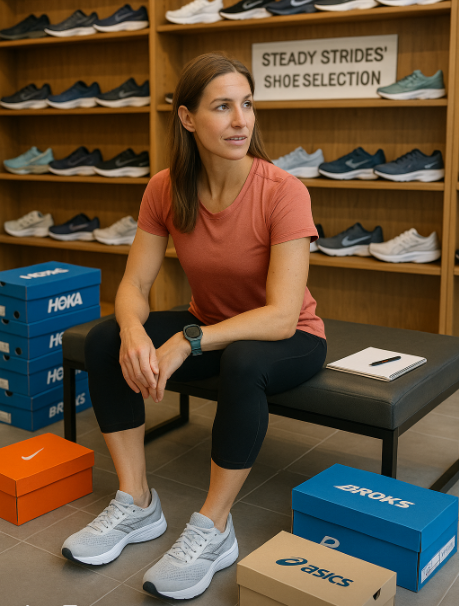When you are new to running, the number of different styles of running shoes can be overwhelming. A good pair of running shoes can make a world of difference in how your feet and legs feel after a run. They can also help prevent injuries. In this article, we’ll cover how a running store can help you find the right pair of shoes, how to DIY this process at home, and finally, a breakdown of different types of running shoes with examples.
How a Running Store Helps You Choose the Right Running Shoes
1. Gait Analysis
Most running stores offer gait analysis by watching you walk or run—sometimes on a treadmill. They analyze your:
- Foot strike (heel, midfoot, or forefoot)
- Ankle movement (pronation/supination)
- Leg and hip alignment
Why it matters: Identifies if you need neutral, stability, or motion control shoes.
2. Foot Measurement
Stores will measure your feet for:
- Length (true shoe size)
- Width (narrow, standard, wide)
- Arch height (flat, medium, high)
Why it matters: Ill-fitting shoes can lead to discomfort and injuries.
3. Shoe Recommendations
Based on gait and foot shape, they’ll suggest:
- Shoe type (neutral, stability, trail, racing)
- Cushioning level (minimal to max)
- Brands and models suited to your feet
4. Wear Test and Feedback
You can usually try shoes by jogging or walking in them.
- Feel how they perform in motion
- Check for pressure points, toe room, and heel slippage
5. Expert Advice
Fit specialists can explain:
- Shoe technology (carbon plates, drop height, etc.)
- Tips for beginners or race-focused runners
- Guidance based on your training goals
6. Return/Exchange Guarantee
Many running stores offer a run-in-them guarantee, so you can return shoes that don’t work after testing.
How to Choose the Right Running Shoes at Home
Not everyone can visit a running store, but you can still make an informed decision with these at-home tests and tools.
Step 1: Wet Foot Test (Find Your Arch Type)
- Wet your foot and step on a paper bag or cardboard.
- Analyze the footprint:
- Flat Arch: Most of your foot shows. → Choose stability or motion control shoes.
- Normal Arch: A clear curve on the inside. → Choose neutral or light stability shoes.
- High Arch: Narrow connection between heel and toe. → Choose neutral shoes with cushioning.

Step 2: Tread Wear Test (Check Old Shoes)
- Look at the wear pattern:
- Inside edge worn: Overpronator → Stability or motion control
- Even wear: Neutral gait → Neutral shoes
- Outer edge worn: Supinator → Cushioned neutral shoes
Step 3: Record Your Running Gait
- Record yourself running barefoot or in socks.
- Watch for ankle motion:
- Rolls inward: Overpronation
- Stays centered: Neutral
- Rolls outward: Supination
Step 4: Match Shoes to Your Goals and Terrain
- Long runs or joint issues? → Max cushioning shoes
- Trail runs? → Trail shoes with grip and protection
- Speed workouts? → Lightweight or racing shoes
- Injury-prone? → Prioritize stability and support
Step 5: Use Brand Shoe Finder Tools
Major brands like Brooks, ASICS, HOKA, and Nike offer online quizzes. Answer a few questions to get personalized shoe suggestions.
Bonus: Buy from a Retailer with a Good Return Policy
Choose sites like Zappos, REI, or Running Warehouse that allow you to test shoes and return them if needed.
Types of Running Shoes (With Examples)
Neutral Running Shoes
- Best for: Normal arch and neutral gait
- Features: Balanced cushioning, flexible
- Example: Brooks Ghost 16
- This is the pair of shoes that I chose as my first pair, and I absolutely love them. They are comfortable, and after I started wearing them, my shin splints and hip soreness went away. When I repurchase new shoes, I might just buy another pair of these shoes. I love them that much.

Stability Running Shoes
- Best for: Mild overpronators
- Features: Supportive midsoles, medial posts
- Example: ASICS GT-2000 12

Motion Control Shoes
- Best for: Severe overpronators, flat feet
- Features: Firm, structured support
- Example: Brooks Beast ’24 / Ariel ’24


Max Cushion Shoes
- Best for: Long runs or joint sensitivity
- Features: Thick midsoles, soft ride
- Example: HOKA Clifton 9

Lightweight / Racing Shoes
- Best for: Speed workouts, races
- Features: Lightweight, responsive, carbon plate (optional)
- Examples: Nike Vaporfly 3, Saucony Kinvara 14


Trail Running Shoes
- Best for: Uneven terrain, trails
- Features: Grippy outsoles, protective uppers
- Example: Salomon Speedcross 6

Minimalist Shoes
- Best for: Experienced runners wanting ground feel
- Features: Low drop, minimal cushioning
- Example: Merrell Vapor Glove 6

Daily Trainers
- Best for: Everyday running
- Features: Durable, comfortable, versatile
- Example: Nike Pegasus 41

Final Thoughts
Finding the best running shoes doesn’t require a specialty store—though it helps. With simple at-home tests and the right resources, you can confidently choose a pair that supports your stride, fits your foot, and matches your training needs. Let me know what shoes you choose in the comments below.
This post includes affiliate links. I earn a small commission if you buy through them, at no extra cost to you


Leave a Reply